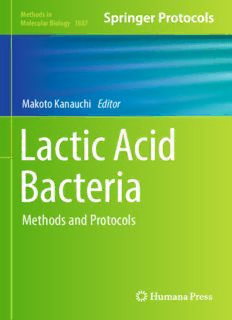Table Of ContentMethods in
Molecular Biology 1887
Makoto Kanauchi Editor
Lactic Acid
Bacteria
Methods and Protocols
M M B
ETHODS IN OLECULAR IO LO GY
SeriesEditor
JohnM.Walker
School of Lifeand MedicalSciences
University ofHertfordshire
Hatfield, Hertfordshire,AL109AB,UK
Forfurther volumes:
http://www.springer.com/series/7651
Lactic Acid Bacteria
Methods and Protocols
Edited by
Makoto Kanauchi
Department of Food Management, Miyagi University, Sendai, Miyagi, Japan
Editor
MakotoKanauchi
DepartmentofFoodManagement
MiyagiUniversity
Sendai,Miyagi,Japan
ISSN1064-3745 ISSN1940-6029 (electronic)
MethodsinMolecularBiology
ISBN978-1-4939-8906-5 ISBN978-1-4939-8907-2 (eBook)
https://doi.org/10.1007/978-1-4939-8907-2
LibraryofCongressControlNumber:2018960875
©SpringerScience+BusinessMedia,LLC,partofSpringerNature2019
Thisworkissubjecttocopyright.AllrightsarereservedbythePublisher,whetherthewholeorpartofthematerialis
concerned,specificallytherightsoftranslation,reprinting,reuseofillustrations,recitation,broadcasting,reproduction
onmicrofilmsorinanyotherphysicalway,andtransmissionorinformationstorageandretrieval,electronicadaptation,
computersoftware,orbysimilarordissimilarmethodologynowknownorhereafterdeveloped.
Theuseofgeneraldescriptivenames,registerednames,trademarks,servicemarks,etc.inthispublicationdoesnotimply,
evenintheabsenceofaspecificstatement,thatsuchnamesareexemptfromtherelevantprotectivelawsandregulations
andthereforefreeforgeneraluse.
Thepublisher,theauthors,andtheeditorsaresafetoassumethattheadviceandinformationinthisbookarebelievedto
betrueandaccurateatthedateofpublication.Neitherthepublishernortheauthorsortheeditorsgiveawarranty,
expressorimplied,withrespecttothematerialcontainedhereinorforanyerrorsoromissionsthatmayhavebeenmade.
Thepublisherremainsneutralwithregardtojurisdictionalclaimsinpublishedmapsandinstitutionalaffiliations.
This Humana Press imprint is published by the registered company Springer Science+Business Media, LLC, part of
SpringerNature.
Theregisteredcompanyaddressis:233SpringStreet,NewYork,NY10013,U.S.A.
Preface
Lacticacidbacteriahavetraditionallybeenusedinfoodproductionasimportantfermenta-
tive bacteria. They have been used to prepare dairy products such as yogurt and cheese,
alcoholic beverages such as wine and whisky, and seasonings such as soy sauce and fish
products.
In 1908, Metchnikoff reported that lactic acid bacteria in yogurt improve intestinal
conditions.Asaresultofthatbenefit,lifespanextensioncanbeexpectedasaninfluencefrom
thebacteria.ResearchintolacticacidbacteriaforprobioticuseadvancedafterMetchnikoff’s
reports.Generally,hundredsofspecies,100trillioncellsofbacteria,arepresentasintestinal
flora in human intestines. Many researchers have reported on the role of bacteria as a
component of the bacterial flora in human intestines. Recently, the bacteria have been
used in medicine as an intestinal medicine. Moreover, immunobiotics using lactic acid
bacteriahavebeeninvestigatedrecentlybymanyscholars.Consequently,lacticacidbacteria
are used widely for human life. Many scholars hope to know more about how professional
researchersevaluatethevariouslacticacidbacteriafunctions.
ThisvolumeoftheMethodsinMolecularBiologyseriesprovidesacollectionofprotocols
fornumerousexperimentalapproachesusedbytheauthorsforlacticacidbacteriaresearch,
suchastheisolationoflacticacid,alongwithapplicationsoflacticacidforfoodproduction
andhealthyfunction,in16chaptersdividedintothreeparts.Allauthorshavecontributedin
the format used in the Methods in Molecular Biology series. In these explanations, the
Materials sections list all the chemicals, reagents, buffers, and other materials used for the
protocols.Furthermore,detaileddescriptionsofeveryprotocolareprovidedintheMethods
section. They are expected to lead to the successful completion of each method. Some
emergentdifficultiesor techniquesforeachprotocolarepresentedintheNotessection.
InPartI,weexplainbacteriametabolism,methodsofisolatinglacticacidbacteriafrom
natural substances, and bacteriocin as antibacterial substances produced by lactic acid
bacteria. Bacteriocin is a noteworthy substance that is recognized throughout the world
foritsuseasanantibacterialsubstanceinfood.Therefore,methodsofselectingalacticacid
bacteria strain to produce bacteriocin and evaluation of bacteriocin produced from the
bacteria are described. Furthermore, lactic acid bacteria produces lactic acid from sugar,
but the bacteria are also in a stress condition. As a result of the stress response to acid,
internal pH changes considerably. Actually, internal pH is an important indication for the
foodindustryandmicrobiologyusingthebacteria.Therefore,methodsofassayingpHare
alsodescribedinthissection.
Secondly,wepresentanapplicationforthefoodindustryinPartII.Anauthorprovides
methodsforcountingmicroorganismssuchaslacticacidbacteria,yeast,andmoldinyogurt,
andmethodsforqualityanalysisortexture.Furthermore,thepolysaccharideproducedfrom
lacticacidbacteriaismentionedsuccessivelyinthreechapters.Thepolysaccharidenotonly
has a relation to yogurt texture but also has a role in improving immunity. The authors
provideevaluationmethodsandanalyticalmethodsfor thepolysaccharideandtheproduc-
tion of lactic acid bacteria. Furthermore, in food production, the growth of lactic acid
bacteria is known to spoil the quality of food. Detection of spoilage of lactic acid bacteria
inbeer usingPCRmethodisdemonstratedbytheauthors.
v
vi Preface
Finally, beneficial effects of lactic acid bacteria are presented in Part III. The authors
describe methods for the evaluation of detoxification by biosorption of heavy metals by
lacticacidbacteria,productionofimmunobioticsbythebacteria,adhesionofthebacteriato
intestinal mucosa, and neutralization of lipopolysaccharides (LPS) by the bacteria. Many
lacticacidbacteriahavehealthyfunctionafteroralingestionasprebiotics.Wehopetoapply
theresultstomanyresearcheffortsinthedomainsof foodscienceandhealthscience.
I would like to acknowledge all authors for kindly contributing their chapters. We are
especiallygratefultotheSeriesEditorDr.JohnWalkerandtheEditorofSpringerProtocols,
David C. Casey, for their assistance, and to the information technology department for
providing the requisite framework, which greatly enhanced the compilation of the book
chapters.
Sendai,Japan MakotoKanauchi
Contents
Preface ..................................................................... v
Contributors................................................................. ix
PART I IDENTIFICATION AND METABOLISMS OF LAB
1 IsolationandIdentificationofLacticAcidBacteriafrom
EnvironmentalSamples.................................................. 3
AkihitoEndo,YasuhiroTanizawa,andMasanoriArita
2 BasicAntibacterialAssaytoScreenforBacteriocinogenicLactic
AcidBacteriaandtoElementarilyCharacterizeTheirBacteriocins ............ 15
KensukeArakawa
3 AssayingD-BodyAminoAcidsasD-AlanineandAminoAcidRacemase
(AARase)ActivityUsingNADHOxidoreductionEnzymicSystem............ 23
NatsukiMatsumotoandMakotoKanauchi
4 IntracellularpHDeterminationfor theStudyofAcidToleranceof
LacticAcidBacteria ..................................................... 33
HiromuKudoandYasukoSasaki
PART II APPLICATIONS OF FOOD INDUSTRIES OF LABS
5 YogurtProduction...................................................... 45
SeijiNagaoka
6 Purification,RheologicalCharacterization,andVisualizationof
Viscous,Neutral,Hetero-exopolysaccharideProducedbyLactic
AcidBacteria ........................................................... 55
S.Ikeda,D.Kondoh,N.P.D.Aryantini,T.Urashima,andK.Fukuda
7 StructuralAnalysisofExopolysaccharidesfromLacticAcidBacteria........... 67
GerritJ.Gerwig
8 PreparationofExopolysaccharideSynthesizedbyLacticAcidBacteria......... 85
JunkoNishimura
9 PCRAnalysisMethodsforDetectionandIdentification
ofBeer-SpoilageLacticAcidBacteria...................................... 95
S.Asano,M.Shimokawa,andK.Suzuki
10 IsolationofLacticAcidBacteriaEliminatingTrimethylamine(TMA)
forApplicationtoFisheryProcessing...................................... 109
SatoshiMohriandMakotoKanauchi
11 ScreeningtheLacticAcidBacteriaconvertingHydroxyFattyAcid
fromUnsaturatedFattyAcid............................................. 119
MakotoKanauchi
vii
viii Contents
PART III HEALTHY FUNCTIONS OF LABS
12 ScreeningandCharacterizationofImmunobioticLacticAcid
BacteriawithPorcineImmunoassaySystems ............................... 131
ValeriaGarcia-Castillo,LeonardoAlbarracin,HarukiKitazawa,
andJulioVillena
13 BiosorptionofHeavyMetalsbyLacticAcidBacteriaforDetoxification........ 145
HidekiKinoshita
14 AdhesionofLactobacillustoIntestinalMucin .............................. 159
KeitaNishiyamaandTakaoMukai
15 EliminatingLipopolysaccharide(LPS)UsingLacticAcidBacteria(LAB)
andaFractionofitsLPS-EliminationProtein .............................. 167
MakotoKanauchi,AyakaKondo,andKyokoAsami
16 CloningandExpressionofLipopolysaccharideEliminationProtein(LEP)
inLacticAcidBacteria................................................... 175
KyokoAsamiandMakotoKanauchi
Index ...................................................................... 189
Contributors
LEONARDOALBARRACIN (cid:1) LaboratoryofImmunobiotechnology,ReferenceCentrefor
Lactobacilli(CERELA-CONICET),Tucuman,Argentina;FoodandFeedImmunology
Group,GraduateSchoolofAgriculturalScience,TohokuUniversity,Sendai,Japan;
LaboratoryofComputingScience,FacultyofExactSciencesandTechnology,Tucuman
University,Tucuman,Argentina
KENSUKE ARAKAWA (cid:1) GraduateSchoolofEnvironmentalandLifeScience,Okayama
University,Okayama,Japan
MASANORIARITA (cid:1) CenterforInformationBiology,NationalInstituteofGenetics,Mishima,
ShizuokaPrefecture,Japan;RIKEN,CenterforSustainableResourceScience,Kanagawa,
Japan
N.P.D.ARYANTINI (cid:1) DepartmentofLifeandFoodSciences,ObihiroUniversityof
AgricultureandVeterinaryMedicine,Obihiro,Hokkaido,Japan
KYOKOASAMI (cid:1) DepartmentofFoodManagement,MiyagiUniversity,Sendai,Miyagi,Japan
S.ASANO (cid:1) ResearchLaboratoriesforAlcoholBeverages,DepartmentofFermentationand
MicrobiologyTechnology,AsahiBreweries,Ltd.,Ibaraki,Japan
AKIHITOENDO (cid:1) DepartmentofFood,AromaandCosmeticChemistry,TokyoUniversityof
Agriculture,Hokkaido,Japan
K.FUKUDA (cid:1) DepartmentofLifeandFoodSciences,ObihiroUniversityofAgricultureand
VeterinaryMedicine,Obihiro,Hokkaido,Japan;DepartmentofAgricultureandAnimal
Science,ResearchCenter forGlobalAgromedicine,Obihiro,Hokkaido,Japan
VALERIA GARCIA-CASTILLO (cid:1) LaboratoryofBacterialPathogenicity,FacultyofBiological
Sciences,UniversityofConcepcion,Concepcion,Chile;LaboratoryofImmunobiotechnology,
ReferenceCentreforLactobacilli(CERELA-CONICET),Tucuman,Argentina;Food
andFeedImmunologyGroup,GraduateSchoolofAgriculturalScience,TohokuUniversity,
Sendai,Japan
GERRITJ.GERWIG (cid:1) MicrobialPhysiology,GroningenBiomolecularSciencesand
BiotechnologyInstitute(GBB),UniversityofGroningen,Groningen,TheNetherlands
S.IKEDA (cid:1) DepartmentofFoodScience,UniversityofWisconsin-Madison,Madison,WI,USA
MAKOTOKANAUCHI (cid:1) DepartmentofFoodManagement,MiyagiUniversity,Sendai,Miyagi,
Japan
HIDEKI KINOSHITA (cid:1) LaboratoryofFoodBiochemistry,DepartmentofBioscience,Schoolof
Agriculture,TokaiUniversity,Kumamoto,Japan
HARUKIKITAZAWA (cid:1) FoodandFeedImmunologyGroup,GraduateSchoolofAgricultural
Science,TohokuUniversity,Sendai,Japan;InternationalEducationandResearchCenter
forFoodandAgriculturalImmunology(CFAI),GraduateSchoolofAgriculturalScience,
TohokuUniversity,Sendai,Japan
AYAKAKONDO (cid:1) DepartmentofFoodManagement,MiyagiUniversity,Sendai,Miyagi,
Japan
D.KONDOH (cid:1) DivisionofBasicVeterinaryMedicine,ObihiroUniversityofAgricultureand
VeterinaryMedicine,Obihiro,Hokkaido,Japan
HIROMU KUDO (cid:1) MeijiUniversity,Kanagawa,Japan
NATSUKIMATSUMOTO (cid:1) DepartmentofFoodManagement,MiyagiUniversity,Sendai,
Miyagi,Japan
ix
x Contributors
SATOSHIMOHRI (cid:1) DepartmentofFoodManagement,MiyagiUniversity,Sendai,Miyagi,
Japan
TAKAO MUKAI (cid:1) DepartmentofAnimalScience,SchoolofVeterinaryMedicine,Kitasato
University,Towada,Aomori,Japan
SEIJINAGAOKA (cid:1) FermentedMilkDevelopmentDepartment,FoodDevelopmentLaboratories,
R&DDivision,MeijiCo.,Ltd.,Hachiouji,Tokyo,Japan
JUNKONISHIMURA (cid:1) DepartmentofLifeandEnvironmentalScience,FacultyofEngineering,
HachinoheInstituteofTechnology,Hachinohe,Aomori,Japan
KEITANISHIYAMA (cid:1) DepartmentofMicrobiology,SchoolofPharmacy,KitasatoUniversity,
Tokyo,Japan
YASUKOSASAKI (cid:1) MeijiUniversity,Kanagawa,Japan
M.SHIMOKAWA (cid:1) ResearchLaboratoriesforAlcoholBeverages,DepartmentofFermentation
andMicrobiologyTechnology,AsahiBreweries,Ltd.,Ibaraki,Japan
K.SUZUKI (cid:1) ResearchLaboratoriesforAlcoholBeverages,DepartmentofFermentationand
MicrobiologyTechnology,AsahiBreweries,Ltd.,Ibaraki,Japan
YASUHIROTANIZAWA (cid:1) Center forInformationBiology,NationalInstituteofGenetics,
Mishima,ShizuokaPrefecture,Japan
T.URASHIMA (cid:1) DepartmentofLifeandFoodSciences,ObihiroUniversityofAgricultureand
VeterinaryMedicine,Obihiro,Hokkaido,Japan
JULIO VILLENA (cid:1) LaboratoryofImmunobiotechnology,ReferenceCentreforLactobacilli
(CERELA-CONICET),Tucuman,Argentina;FoodandFeedImmunologyGroup,
GraduateSchoolofAgriculturalScience,TohokuUniversity,Sendai,Japan
Description:This detailed book provides a collection of protocols for numerous experimental approaches perfected by the authors for lactic acid bacteria (LAB) research. Split in to three parts, the volume delves into the identification and metabolism of LABs, the applications of the bacteria for the food indust

